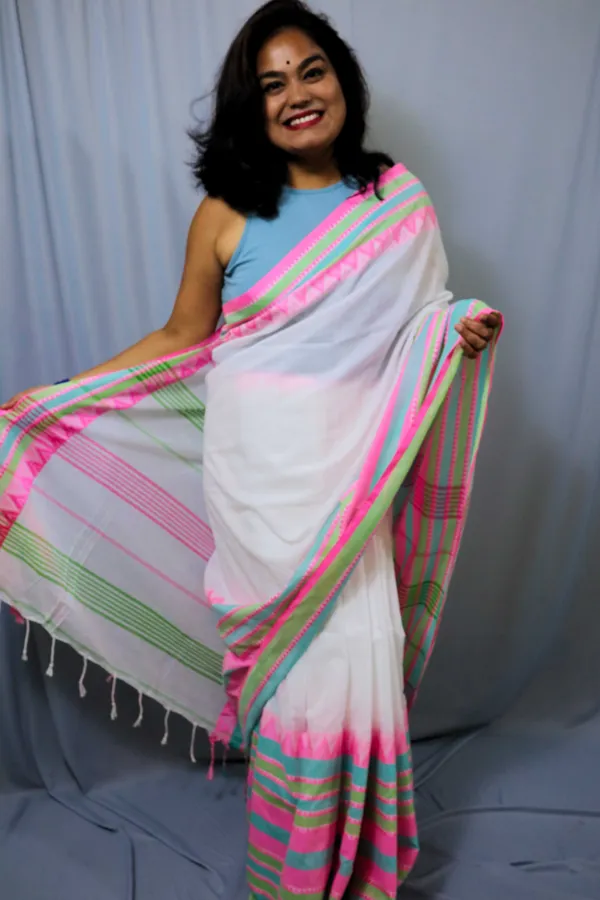When one thinks of Khadi, the image of a man sitting on a Charkha pops into our brains. It comes from the word Khaddar, a hand-spun and woven natural fibre cloth introduced by Mahatma Gandhi during the Indian Subcontinent’s freedom struggle.
Khadi is a term used throughout India, Pakistan and Bangladesh.
History of Khadi
- The first piece of this hand-woven fabric was manufactured in the Sabarmati Ashram in 1917-18 to commence the Boycott Movement in India. Later, when the Swadeshi Movement took place, Khadi was publicized to the Indian population as an alternative to the British textiles.
- The coarseness of the cloth made Gandhiji name it Khadi. He re-discovered this fabric as an initiation of empowerment. He believed that more than sales, this hand-woven fabric would bring about better change in the daily lives of the people.
- In 1922, Mahatma Gandhi asserted Indian National Congress (INC) the need to launch Khadi Department for spinning activities.
- Due to huge work, a semi-independent body, the All India Khadi Board (AIKB), was formed in association with INC Khadi Department at provincial and district levels in 1924.
- In 1925, the All India Spinner Association (AISA) was formed. It comprised the INC Khadi Department and AIKB. The founder of AISA was Mahatma Gandhi. Later, Jawaharlal Nehru and Rajinder Prasad were on its executive board.
- Mahatma Gandhi encouraged people to spin yarn, weave their fabric and wear it with pride, establishing and maintaining the heritage of the country.
- Later, in the year 1925, the fabric was commercially launched by the All India Spinners Association.
Post Independence
- In 1948, the role of Rural Cottage Industries was recognised by India in its Industrial Policy Resolution.
- In 1949, Amber Charkha was invented by Shri Ekambernathan.
- In January 1953, the All India Khadi & Village Industries Board (AIKVIB) was set up by the Government of India.
- In 1955, a decision was taken to replace the Board with a statutory body. In 1956, the Khadi and Village Industries Commission (KVIC) Act was passed.
- In 1957, Khadi and Village Industries Commission (KVIC) came into existence as a statutory organisation.
- As per KVIC, in 2017, about 460,000 people were employed in these fabric’s products making industries.
- Many advanced weaving techniques emerged and continued flourishing even after Independence.
- Even today, the Khadi and Village Industries Commission (KVIC) plans and promotes the development of the fabric.
- After the fabric gained considerable fame, KVIC still works continuously to improve the production and other techniques. They also provide employment to the Indian artisans.
What is the process of Making Khadi?
The making of the Khadi fabric might not be very complicated but it is a tedious process as all the steps are hand done and not with the help of automated machines.
- The yarns used for the fabric are made of natural fibres. The use of cotton and silk fibres are very usual.
- The yarns are hand-spun on a spinning wheel called a Charkha.
- These yarns are then wound up on reels and sent to the weavers.
- The weavers use these yarns to weave the fabric. The weaving creates air pockets in the fabric, developing its thermal properties, which means it keeps one cool in summer and warm in winters.
What are the Types of Khadi?
- Cotton Khadi: This fabric is hand-spun and woven using cotton fibres. Cotton Khadi needs to be starched to retain its firm and crisp texture.
- Silk Khadi: Khadi Silk is a blend of cotton (50%) and silk (50%). The fabric is known for its sheen and luxurious appearance. It is expensive than it cotton variation and must be dry-cleaned only. Usually, after the first wash, the Khadi silk fabrics tend to shrink about 3%.
- Woolen Khadi: These are considered the best hand-woven woollens that can be achieved. It is said that Khadi-Pashmina is the purest form of what we know as Cashmere. Haryana, Himachal Pradesh and Jammu Kashmir are well-known places for the woollen variants of the fabric.
What are the Characteristics of Khadi?
- It is a customizable and lightweight fabric, easy to use and quite flexible.
- It is an extremely durable fabric. It lasts for a considerable amount of time without causing much damage and trouble in its usage.
- The weaving of the fabric is such that air pockets get created in it, making it a thermal fabric that keeps one cool in summers and warm in winters.
- It is the only fabric that can be used to make the Indian National flag. Any other fabric used is a punishable offence and the maker is liable for three years of imprisonment and may have to pay a heavy fine to the law.
How to Maintain Khadi?
- These fabrics are easy to maintain. They need to be hand-washed and ironed to get a fresh, refined look.
- Scrubbing the fabric is not recommended.
What is the Current Scenario of Khadi?
- It is very sophisticated with a very minimalistic appeal. It is globally renowned not only for its rich heritage but also for its fashion appeal.
- It is high-quality material in the handloom industry yet very easy to maintain and that has added to its global demand.
- With the increasing innovations and technological advancements in the apparel industry, machines are taking over the manual spinning of the fabric.
- The fabric is available in several variations like hand works ranging from Kantha to hand block printing to sequins added to the simple weave.
- It is a coarse fabric and easy to sew. Patchwork, Phulkari, Kantha, Block printing are easy to do on this fabric.
- The usage of the fabric is no more limited to just Nehru jackets, kurtas and sarees. One can choose from a large variety of apparel today like shirts, pants, dresses etc.
Follow through the Wikipedia page.

